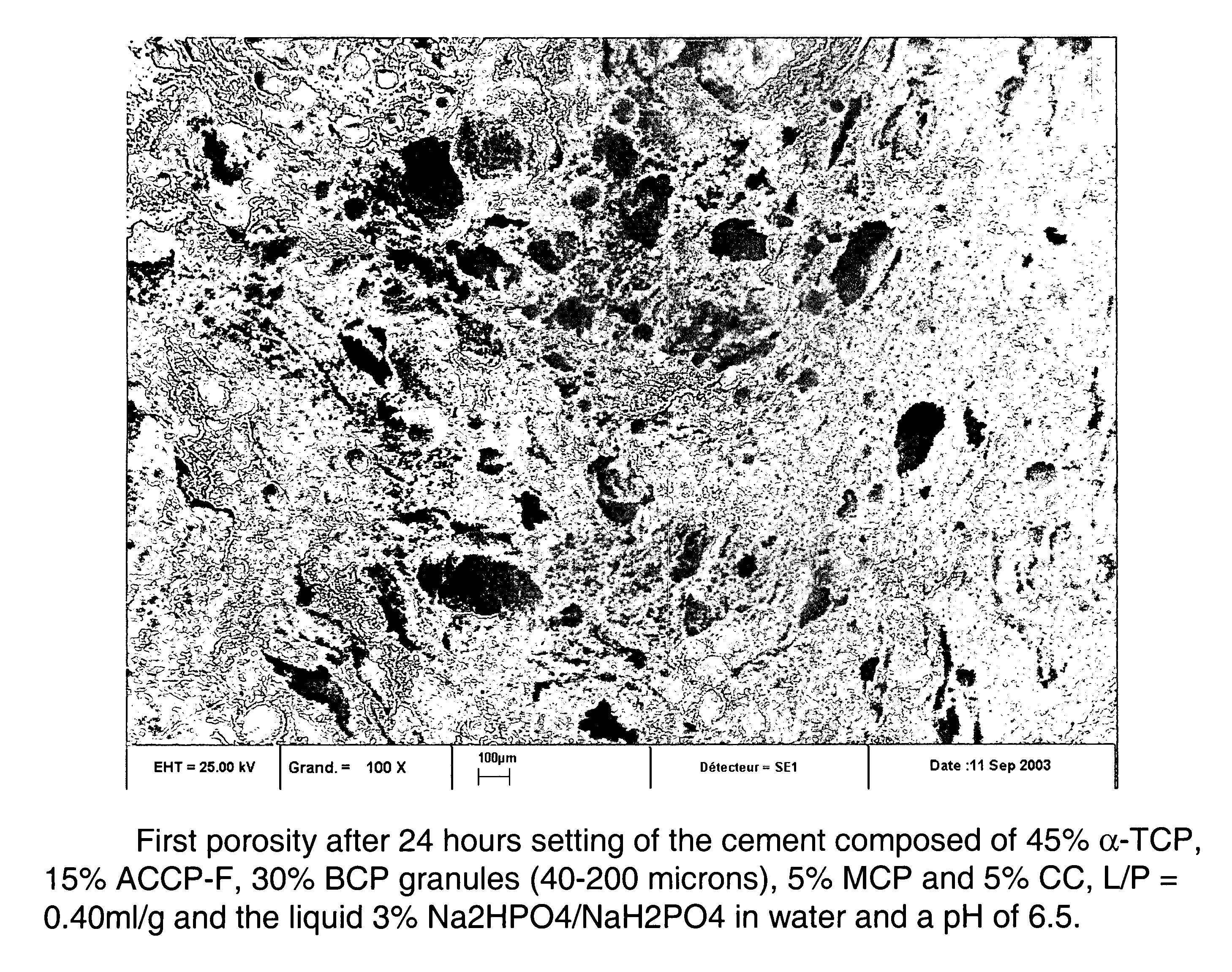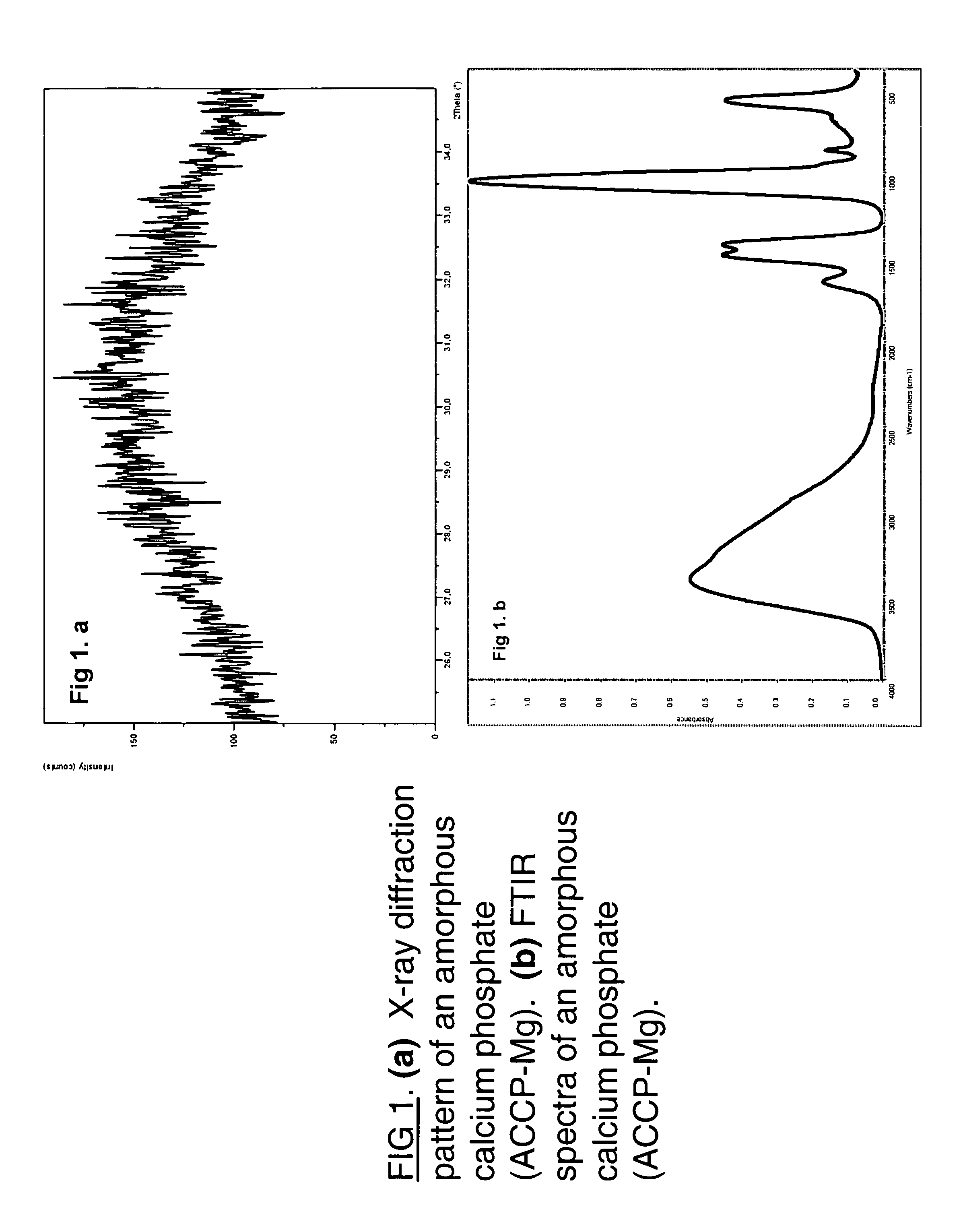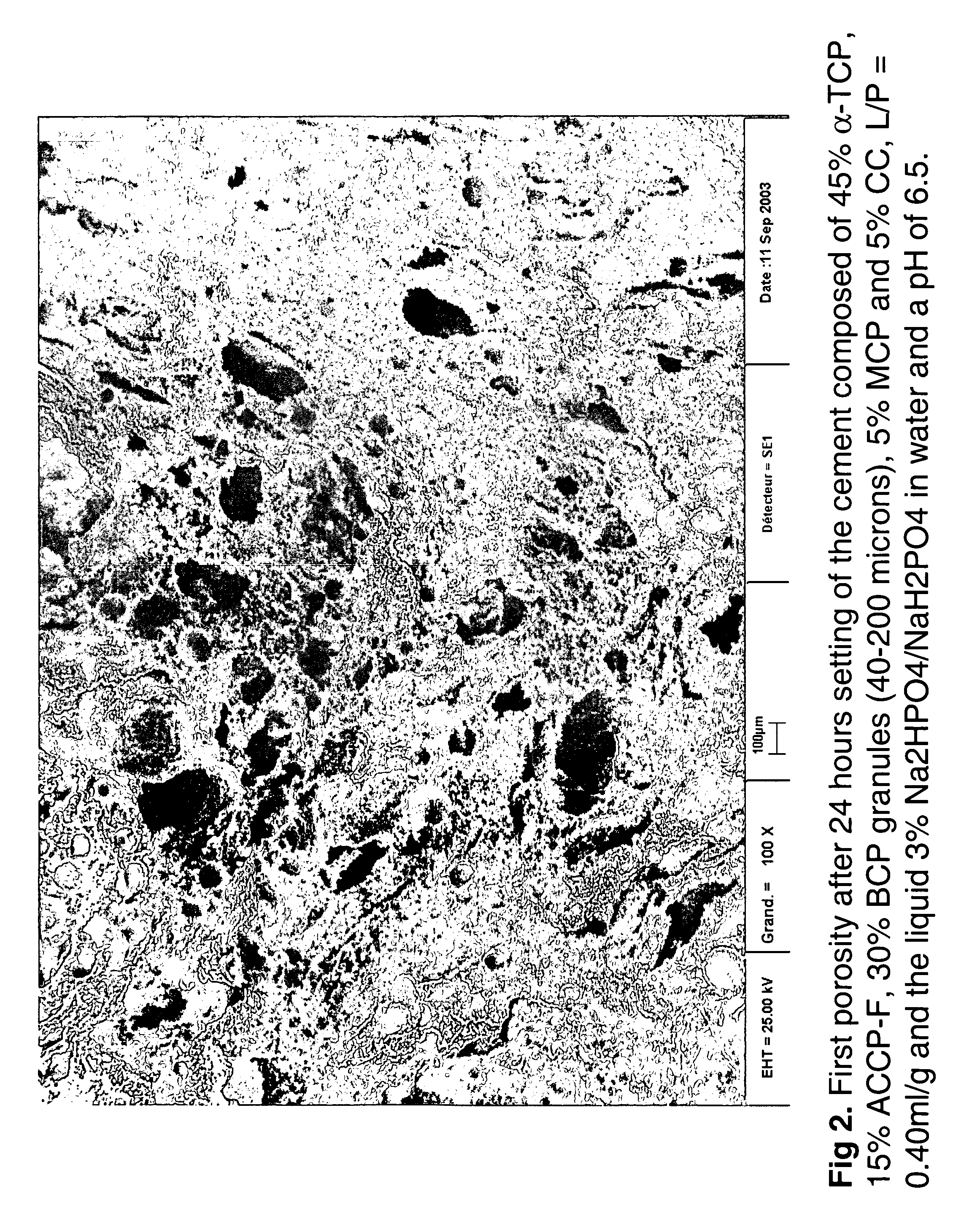Macroporous, resorbable and injectible calcium phosphate-based cements (MCPC) for bone repair, augmentation, regeneration, and osteoporosis treatment
a technology of calcium phosphate-based cements and macroroporous cements, which is applied in the field of methods, can solve the problems of slow bioresorbability rate, and achieve the effect of easy control
- Summary
- Abstract
- Description
- Claims
- Application Information
AI Technical Summary
Benefits of technology
Problems solved by technology
Method used
Image
Examples
example 1
Preparation of Amorphous Calcium Phosphate (ACP) and Modified ACP at 25° C.
(i) Amorphous Calcium Phosphate: ACP.
[0037]Reagents: Na2HPO4 .2H2O (0.25 mol / l); CaCl2 .2H2O (0.75 mol / l). (These concentrations gave a final phosphate concentration of 0.15 mol / l and a Ca / P molar ratio of 1.71).
[0038]The calcium solution was added rapidly with stirring to the phosphate solution. All solutions were adjusted to pH 10 with concentrated NaOH prior to mixing. The initial solid phase formed immediately on mixing was filtered, washed (with distilled water+NaOH, pH 10), and then freeze-dried.
(ii) Amorphous Calcium Phosphate Containing Carbonate: ACCP.
[0039]Reagents: Na2HPO4 .2H2O (0.25M), NaHCO3 (0.25M), CaCl2.2H2O (0.75 M). solution molar ratio of CO3 / P=5 / 1.
[0040]The calcium and (phosphate+carbonate) solutions were first adjusted to pH 10 using NH4OH. 100 ml of the calcium solution was quickly added to the stirring phosphate and carbonate solution (100 ml). Precipitate was filtered, washed (with di...
example 2
Preparation of a Calcium Phosphate Cement Formulation
[0047]Cement samples with different liquid-to-powder ratio were prepared. For one formulation, the powder of the cement contained 45% α-TCP, 15% ACCP, 30% BCP macroporous granules (40-200μ), 5% MCPA and 5% CC. The HA / β-TCP of the BCP was 60 / 40. The liquid / powder ratio UP of the cements varied from 0.30 or 0.32 or 0.35 or 0.40 ml / g. The liquid concentration was 3% Na2HPO4 / NaH2PO4 in water, and the liquid pH varied from 5 to 10. The setting times initial and final were determined with Gilmore needles. Teflon molds were used to prepare cement cylinders with a height of 12 mm and a diameter of 6 mm and soaking was carried out during 1 h, 24 h, 1, and 3 days in Ringer's solution at 37° C. prior to determination of the compressive strength. Scanning electron microscopy (SEM) was used for microstructural analysis. Finally, the samples were crushed using a mortar and pestle for X-ray powder diffraction analysis. Mercury porosimetry was us...
example 3
In Vitro Cell Response to Cement Preparations
[0049]Eight formulations with different amorphous calcium phosphate were prepared to determine cell response.[0050]Formulation A, α-TCP, ACCP-Zn, MCPA and CC[0051]Formulation B, α-TCP, ACCP-Zn, MCPA and CC+BCP granules (40-200 microns)[0052]Formulation C, α-TCP, ACCP-Mg, MCPA and CC+BCP granules (40-200 microns)[0053]Formulation D, α-TCP, ACCP-F, MCPA and CC+BCP granules (40-200 microns)[0054](For all formulations, the BCP macroporous granules consisted of 60HA / 40β-TCP).[0055]Liquid-to-powder ratio L / P=0.40 ml / g; Liquid pH, 6.5; 1 hour and 24 hours after setting, the cements were soaked at 37° C. in Ringer's solution. Discs samples were prepared and sterilized using autoclave for 30 minutes at 121° C.
[0056]MC3T3-E1 cells, a non-transformed cell line established from newborn mouse calvarias, were used. MC3T3-E1 cells were grown in alpha MEM medium supplemented with 10% FCS, 1% penicillin / streptomycin and 1% L-Glutamine. Cells were subcultu...
PUM
| Property | Measurement | Unit |
|---|---|---|
| particle size | aaaaa | aaaaa |
| particle size | aaaaa | aaaaa |
| setting time | aaaaa | aaaaa |
Abstract
Description
Claims
Application Information
 Login to View More
Login to View More - R&D
- Intellectual Property
- Life Sciences
- Materials
- Tech Scout
- Unparalleled Data Quality
- Higher Quality Content
- 60% Fewer Hallucinations
Browse by: Latest US Patents, China's latest patents, Technical Efficacy Thesaurus, Application Domain, Technology Topic, Popular Technical Reports.
© 2025 PatSnap. All rights reserved.Legal|Privacy policy|Modern Slavery Act Transparency Statement|Sitemap|About US| Contact US: help@patsnap.com



